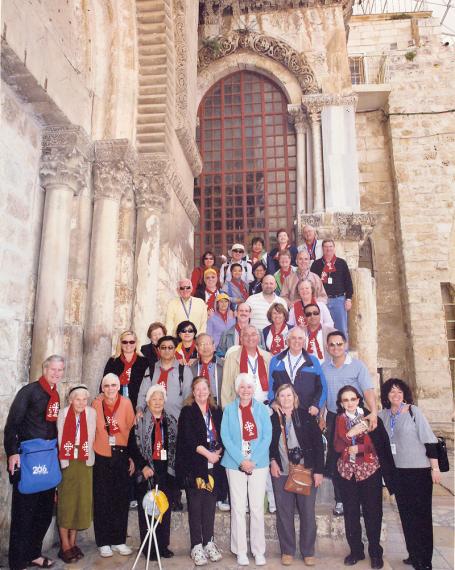Hillary Kaell, Walking Where Jesus Walked: American Christians and Holy Land Pilgrimage (2014), Introduction, Chapter 4
The takeaway message from this week’s classes is that the theological and liturgical situation induced by the Second Vatican Council’s reforms now appears to be second-nature. It is just the way things are, at least for young people in Catholic higher education. In Chapter 4 of her book, Walking Where Jesus Walked, Hillary Kaell says that American Catholics were “the most affected by changes wrought in Rome.” Commentators call the reforms of Vatican II “‘a spiritual earthquake.’” The “middle-old” Catholic pilgrims with whom Kaell traveled to the Holy Land had lived through these changes firsthand, and their faith lives reflect their attempts to grapple with the psychological and theological effects of this earthquake.
In contrast, the college students in my classroom have grown up in a post-Vatican II Church. At the beginning of the semester I asked them if they had ever heard of Vatican II. Some raised their hands, but many didn’t. Most were not able to tell me about the Council beyond a few generalizations: “It happened in Rome,” one student said. Another comment: “Mass used to be in Latin.” They were aware that the Church had changed in their parents’ (or grandparents’) lifetimes. But I was struck by their vague sense of the role of the Council’s role in the life of the Church. In contrast, Kaell’s middle-old pilgrims were keenly aware of the Council’s reforms; they felt both obliged to embrace them and querulous about their ability to do so, at least in the way that their friends and neighbors (and children) were.
R. L. Stirrat’s book, Power and Religiosity in a Post-Colonial Setting: Sinhala Catholics in Contemporary Sri Lanka, talks about the reception of Vatican II. His description focuses on how priests’ roles changed in the 1960s. They became activists, joined marches, left the physical confines of their parish, got out “into the streets,” and were seen on the move and in the world. This could have been a nice counterpoint to Kaell’s more grassroots story about Vatican II, but we did not actually have time to discuss this part of Stirrat’s book. We focused on the more recent history of the Sri Lankan shrine that is the focus of Power and Religiosity. Religious Studies Professor Mathew Schmalz led our class discussion one of the days that week. He showed slides of his trip to Kudagama, and talked about how this shrine had become affiliated with the Catholic Charismatic Renewal in the years after Stirrat completed his research. Our discussion focused on Charismatic Catholicism, leaving the topic of the Second Vatican Council for this week.
This was also a week when I had asked if anyone in the class had been to the Holy Land or knew someone who had gone on a Holy Land pilgrimage. One of my students had an uncle who had gone twice on Holy Land pilgrimages. The student offered to speak to his uncle about his experiences on these trips, and I invited him to report about his conversation during class. He gave his uncle a call a few days before class. As I expected, his uncle was excited to share his stories about going to the Holy Land. For more than ten minutes, my student talked about his uncle’s experience using the notes of his conversation, and it looked like he could have spoken longer.
If there is a takeaway from this week, it is that teaching the grassroots reception of Vatican II is mediated through contemporary college students’ relationships with their older family members. I was not surprised it was a member of my student’s parents’ generation who had gone on a Holy Land pilgrimage. Asking our students to investigate Vatican II’s grassroots will also mean asking them to dive into their relationships with older family members, perhaps more deeply than they had before enrolling in a class on Global Catholicism.

